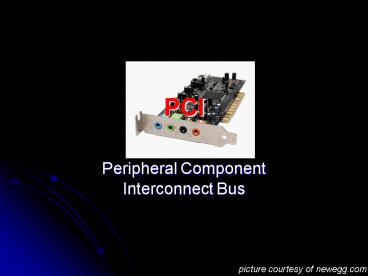PCI - PowerPoint PPT Presentation
1 / 13
Title: PCI
1
PCI
- Peripheral Component Interconnect Bus
picture courtesy of newegg.com
2
History
- PCI was developed by Intel and introduced in 1993
- ISA, the bus architecture used at the time had
become a bottleneck within the computer - Intel formed a PCI special interest group,
contributed technology, and encouraged an open
industry specification to prevent the
complication of competing buses
3
History
- PCI provided a tenfold performance gain over ISA
- Plug and Play (PnP) capabilities made it easier
for users to add expansion cards to their
computers - PCI is used today in almost every computer
platform
4
Specs
- Parallel Communication
- First version ran at 33MHz with 32 bit bus
(133MBps) - Current version runs at 66MHz with 64 bit bus
- Bus Clock Signal 133 MHz
- Theoretical Max Transfer Rate 1GB/s
5
PCI
- An interconnection system between a
microprocessor and attached devices in which
expansion slots are closely spaced for high speed
operations. - Transmits 32 bits at a time in a 124-pin
connection and 64 bits in a 188-pin connection in
an expanded implementation. - Uses all active paths to transmit both address
and data signals, sending the address on one
clock cycle and the data on the next (Burst Mode)
6
PCI
- The PCI bus treats all transfers as a burst
operation. - Each cycle begins with an address phase followed
by one or more data phases. - Data phases may repeat indefinitely, but are
limited by a timer that defines the maximum
amount of time that the PCI device may control
the bus. - This timer is set by the CPU as part of the
configuration space. Each device has its own
timer - The same lines are used for address and data. The
command lines are also used for byte enable
lines. This is done to reduce the overall number
of pins on the PCI connector
7
PCI Bus Signals
- Address/Data Bus 64bit Address 64bit Data,
Time Multiplexed - System Bus 2bits Clock/Reset
- Interface Control Bus 7bits Ready,
Acknowledge, Stop. - Parity Bus 2 bits, 1 for the 32 LSBs and 1
for the 32 MSB bits - Errors Bus 2 bits, 1 for Parity and 1 for
System - Command/Byte Enable 8 bits (0-3 _at_ 32bit, and
4-7_at_ 64bit Bus) - 64MHz Control 6 bits (2) Enable/Running,
(2) Present, (2) Ack/Req - Cache 2 Bits
- Interrupt bus 4 bits
- JTAG Bus 5 bits
- Power 5, 3.3, 12, -12v, GND
8
Longevity
- PCI is processor independent, so it can function
in various markets with little change - Not wired into a specific processor, so
manufacturers could standardize their I/O across
multiple product groups - Flexible in its ability to support multiple form
factors
9
Longevity
- There are a limited number of hardware interrupts
(IRQs) and the PCI bus is designed to share them.
- ISA cards require a fixed IRQ to be assigned to
the device
10
PCI
- PCI was used from 1993 2004 as the standard
local bus system within a computer - PCI specification standardized how expansion
cards such as network cards install themselves
and exchange information with the CPU - CPU clock speed has increased from 66 MHz in 1993
to over 3GHz - The operational frequency of PCI has only
increased once from 33MHz to 66MHz
11
PCI - X
- PCI Extended
- Improves upon the speed of PCI from 133 Mbps
to up to 1Gbps - Created for servers to increase performance of
high bandwidth devices, such as Gigabit Ethernet - Designed jointly by IBM, HP, and Compaq
12
PCI - Express
- 3GIO (Third Generation Input/Output)
- An I/O interconnect bus standard that expands on
and doubles the data transfer rates of original
PCI. - A two-way, serial connection that carries data in
packets along two pairs of point-to-point data
lanes, compared to the single parallel data bus
of traditional PCI that routes data at a set
rate. - Initial bit rates reach 2.5Gb/s per lane
direction with data transfer rates of
approximately 256MB/s. - 32x PCI Express has transfer rates of 8GB/s per
stream (16GB/s duplex) - It was developed so that high-speed interconnects
such as Firewire, USB 2.0, and Gigabit Ethernet
would have an I/O architecture suitable for their
high transfer speeds.
13
Asus Striker Extreme 775 NVIDIA nForce 680i ATX
(The Ultimate Gaming Motherboard) 339.99
Picture courtesy of newegg.com































